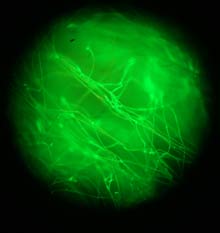Transgenic Worms Make Tough Fibers
Researchers have been trying to make artificial spider silk for decades. Now a startup claims to have overcome one of the main challenges in synthesizing the lightweight, stronger-than-steel fibers.

Kraig Biocraft Laboratories has made genetically modified silkworms that produce fibers incorporating spider-silk proteins. The resulting fibers are much stronger, more flexible, and finer than silk made by normal silkworms. The company says it believes it will be able to match the properties of spider silk within the next year. The company hopes to sell the first generation of fibers to companies that will make stronger everyday silk products. Its ultimate goal is to mass-produce artificial spider silk, which could be used to make very strong and lightweight products including bulletproof vests, composite materials for vehicles and sports equipment, and even new construction materials.
Spiders make many varieties of silk, and many of these fibers are stronger than steel. Mimicking such silk and developing ways of producing it industrially has long been a goal of materials scientists. But spiders are too aggressive to be farmed, so researchers have made transgenic animals that make the spider proteins. But that isn’t enough, because simply producing the protein components of these materials is not enough–you have to mimic the way spiders put them together by spinning a thread.
“Genetic engineers have been focused on making organisms that produce as much spider-silk protein as possible, but this is like dumping a load of bricks in the yard and asking why you don’t have a house,” says Kim Thompson, founder and CEO of Kraig Biocraft, based in Lansing, Michigan. Bacteria, for example, can be made to produce spider-silk proteins, and the Canadian biotech company Nexia even succeeded in creating goats that excreted high levels of spider-silk proteins in their milk. But they lacked the means to assemble these proteins into usable silk.
Other groups have created transgenic silkworms that make spider silk, but the worms didn’t integrate the foreign proteins into the fiber structure, and fiber’s mechanical properties didn’t significantly improve over what natural silkworms make. The worms’ natural systems for spinning fibers are tailored to their own natural proteins. “There’s no reason the silkworms would necessarily include the spider protein in their fiber,” says Randy Lewis, professor of molecular biology at the University of Wyoming. Lewis has sequenced several spider-silk genes.
Kraig Biocraft had to alter the spider-silk proteins so that they would not just be made by the silkworms but also integrated into the structural matrix of the silk fibers. These proteins have chemical structures that fit together tightly to give silk fibers their integrity and strength. The company licensed Lewis’s gene sequences and modified them. Lewis says he’s verified that these spider proteins are chemically integrated into the core of the fiber.
The company’s system for making transgenic silkworms was developed by Malcolm Fraser, professor of biological sciences at the University of Notre Dame. Fraser’s methods for genetic engineering in insects and other animals were used to make the first artificial spider-protein-producing silkworms in the year 2000.
Kraig Biocraft has made 20 new varieties of transgenic silkworms by injecting silkworm embryos with Fraser’s DNA constructs incorporating the modified spider genes, then screening to find worms that have integrated the new genes into their genomes.
The company has not disclosed the results of mechanical tests performed on the fibers made by the engineered silkworms, nor has it released information about how much of the spider protein the animals make. But representatives claim that all of the animals make silks stronger and more flexible than natural silkworm silk and that one variety makes particularly strong fibers that the company has deemed “monster silk.”
“We don’t have much control over how much [spider] protein the transgenics express–some express a little, some a lot,” says Fraser. “We’re currently working on methods to ensure optimal transgenics.”
David Kaplan, chair of biomedical engineering at Tufts University, who has developed biomedical applications for silkworm silk, notes that Kraig Biocraft has not yet published its results in a scientific journal. Kaplan adds that a transgenic silkworm is a promising system for making spider fibers, but notes that over the long-term, large-scale industrial production may not be as viable as growing silk-producing bacteria in vats. The fiber-making process remains a challenge for approaches using bacteria, but researchers at the University of California, Berkeley, are working on microfluidics and other systems designed to mimic the silkworm’s fiber-spinning capabilities.
Kraig Biocraft’s Thompson says the company’s first product is likely to be based on the first versions of silk, which aren’t strong enough for specialized industrial applications. These products will target the $4-billion-a-year raw-silk market in 2011. The company will then pursue industrial applications using much stronger silk.
Keep Reading
Most Popular
Large language models can do jaw-dropping things. But nobody knows exactly why.
And that's a problem. Figuring it out is one of the biggest scientific puzzles of our time and a crucial step towards controlling more powerful future models.
The problem with plug-in hybrids? Their drivers.
Plug-in hybrids are often sold as a transition to EVs, but new data from Europe shows we’re still underestimating the emissions they produce.
Google DeepMind’s new generative model makes Super Mario–like games from scratch
Genie learns how to control games by watching hours and hours of video. It could help train next-gen robots too.
How scientists traced a mysterious covid case back to six toilets
When wastewater surveillance turns into a hunt for a single infected individual, the ethics get tricky.
Stay connected
Get the latest updates from
MIT Technology Review
Discover special offers, top stories, upcoming events, and more.